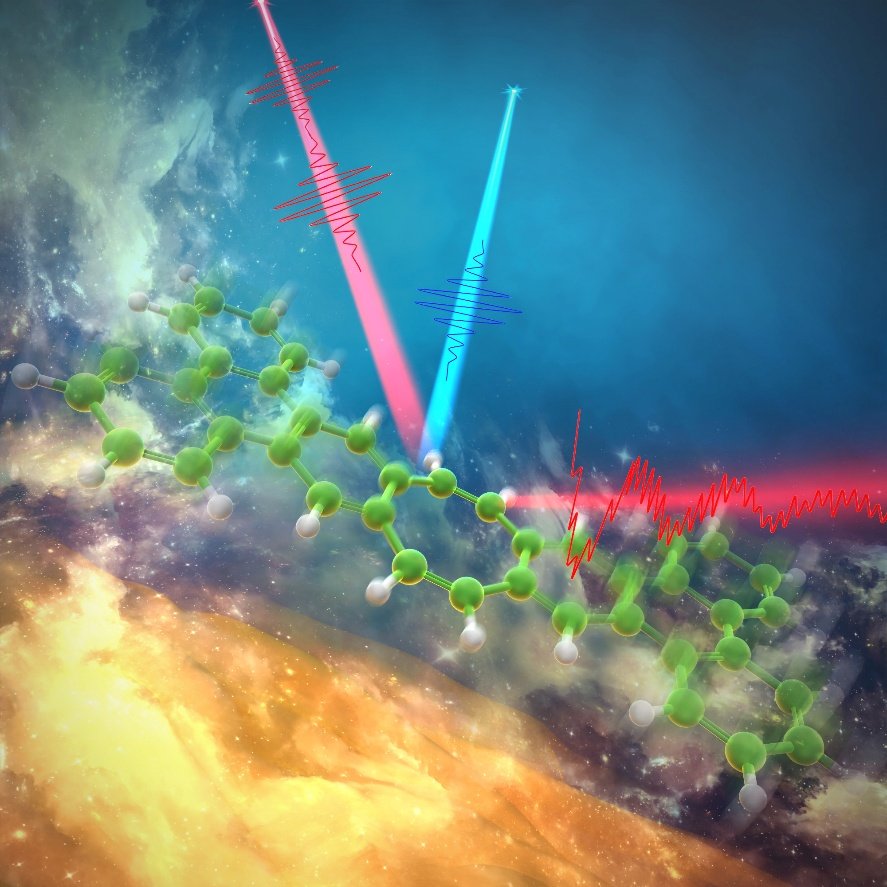We reach more than 65,000 registered users in Dec!! Register Now

Catching Aromaticity in the Act: Direct Real-Time Tracking of How ‘Excited-State Aromaticity’ Drives Molecular Shape Changes
- March 27, 2025
- 2 Views
- 0 Likes
- 0 Comment
Scientists have achieved the first real-time visualization of how "excited-state aromaticity" emerges within just hundreds of femtoseconds and then triggers a molecule to change from bent to planar structure in a few picoseconds. By combining ultrafast electronic and vibrational spectroscopies, the team captured these fleeting structural changes at the molecular level and showed that aromaticity appears before--and then drives--the structural planarization. Their findings lay the groundwork for designing more efficient photoactive materials, such as sensors and light-driven molecular switches, by leveraging the power of aromaticity in excited states.
For the first time, researchers led by Hikaru Kuramochi, Associate Professor at the Institute for Molecular Science/SOKENDAI, have directly tracked how excited-state aromaticity emerges within hundreds of femtoseconds and subsequently drives a molecule's picosecond-scale structural change from a bent to a fully planar shape.
Aromaticity is a foundational concept in chemistry describing the enhanced stability of cyclic molecules whose electrons are delocalized. Although most discussions have focused on molecules in their ground state, the concept of "excited-state" aromaticity has recently been extensively utilized in predicting the structural change and designing the chemical reactivities induced by photoexcitation. While the dynamic properties of excited-state aromaticity have been studied intensively in the past, these have primarily focused on molecules in a "near-equilibrium state," leaving the precise timing and interplay between excited-state aromaticity and structural changes poorly understood. Directly visualizing these ultrafast motions is crucial for designing photoactive materials, such as sensors, adhesives, and switches.
The team used a combination of femtosecond transient absorption and *time-resolved impulsive stimulated Raman spectroscopy* (TR-ISRS)--an advanced "time-domain" Raman technique that covers vibrational frequencies from terahertz to 3000 cm⁻¹ with femtosecond temporal resolution--to capture ultrafast snapshots of a newly synthesized cyclooctatetraene (COT)-based "flapping molecule" called TP-FLAP. By exciting TP-FLAP with a femtosecond laser pulse, then probing its evolving vibrational signals, they could see exactly when and how the molecule's central COT ring planarized. Isotope labeling with ¹³C at the central ring allowed the researchers to confirm which specific vibrational mode accompanied the bent-to-planar transition.
Initial measurements revealed a sub-picosecond (≈590 fs) electronic relaxation that imparts aromatic character to the bent molecule's excited state. The molecule then undergoes planarization in a few picoseconds as indicated by a *frequency shift* in the ring's carbon-carbon stretching vibration. With the help of the isotope labeling (¹³C), a telltale shift in the key C=C stretching frequency was unambiguously shown, confirming that the ring's planarization drives the observed vibrational changes. Calculations of aromaticity indices (e.g., nucleus-independent chemical shifts, NICS) further support that the system is "already aromatic" in the bent excited state and becomes *even more* aromatic as it undergoes planarization.
This study provides the first direct observation of nonequilibrium structural changes governed by excited-state aromaticity. It conclusively shows that aromaticity can emerge within hundreds of femtoseconds, preceding--and then facilitating--the picosecond-scale flattening of the molecule. Beyond deepening our understanding of fundamental light-driven processes, these insights help guide the rational design of photoactive materials, including molecular sensors, tunable fluorescence probes, and photoresponsive adhesives. The TR-ISRS method's ability to track vibrational modes in real time offers a new avenue for exploring other systems featuring excited-state (anti)aromaticity and complex conformational changes.
Nonequilibrium planarization dynamics revealed by TR-ISRS(Credit:copyright Kuramochi group/ created by Science Graphics. Co., Ltd., Restriction:CC BY)
List of Referenes
- Yusuke Yoneda, Tomoaki Konishi, Kensuke Suga, Shohei Saito, Hikaru Kuramochi. Excited-State Aromatization Drives Nonequilibrium Planarization Dynamics. Journal of the American Chemical Society, 2025; DOI: 10.1021/jacs.4c18623
Cite This Article as
No tags found for this post









